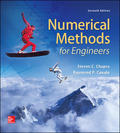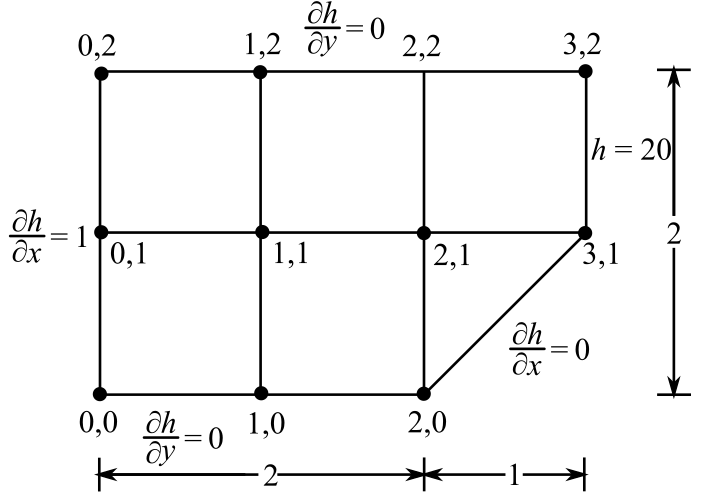
Concept explainers
The velocity of water flow through the porous media can be related to head by D'Arcy's law
where K is the hydraulic conductivity and
To calculate: The water flowsvelocity through the porous media for the Prob. 32.8, if the hydraulic conductivity is
Answer to Problem 9P
Solution:
The water flow velocity at every node is,
| -5.205E-04 | -5.542E-04 | -6.593E-04 | -7.249E-04 |
| -5.079E-04 | -5.315E-04 | -6.989E-04 | -7.942E-04 |
| -4.668E-04 | -3.967E-04 | -4.429E-04 |
Explanation of Solution
Given Information:
Write the expression for D’Arcy’s law.
Here,
The hydraulic conductivity is
Formula used:
Consider the Laplace Equation,
Write the central difference approximation for the second derivative.
Calculation:
Refer to Figure P32.8, draw the nodal diagram.

Recall the Laplace Equation,
The central difference approximation applies for the second derivative in above Laplace equation,
At the node,
Approximate the all external nodes with a central finite difference,
Thus,
Now with a central finite difference, approximate the external nodes.
Solve further,
Substitute (3) and (4) in (2).
Similarly, at the node,
Similarly, at the node,
Similarly, at the node,
Similarly, at the node,
Similarly, at the node,
Similarly, at the node,
Similarly, at the node,
Similarly, at the node,
Thus, the system of all linear equations is,
And,
And,
Write all equation in matrix form.
Use the MATLAB to solve the above equations, write the following code in MATLAB.
The output is,
Thus, the distribution of head of the system is shown below.
| 16.3372 | 17.37748 | 18.55022 | 20 |
| 16.29691 | 17.31126 | 18.4117 | 20 |
| 16.22792 | 17.15894 | 17.78532 |
Now from the above table find the value of
And
Calculate the value of
And,
Calculate all the value of
| 1.04029 | 1.10651 | 1.31126 | 1.44978 |
| 1.01435 | 1.05740 | 1.34437 | 1.58830 |
| 0.93102 | 0.77870 | 0.62638 |
Calculate the value of
Calculate all the value of
| 0.04029 | 0.06623 | 0.13852 | 0.00000 |
| 0.05464 | 0.10927 | 0.38245 | 0.00000 |
| 0.06898 | 0.15232 | 0.62638 |
Now calculate the value of
Substitute the values of
For
Calculate for every node the value of
| 1.04107 | 1.10849 | 1.31855 | 1.44978 |
| 1.01582 | 1.06303 | 1.39771 | 1.58830 |
| 0.93357 | 0.79345 | 0.88583 |
Apply the D’Arcy law to find the discharge velocity in the n direction:
Here,
Now Calculate for the velocity (
Calculate the velocity for every node same way, and got the following table:
| -5.205E-04 | -5.542E-04 | -6.593E-04 | -7.249E-04 |
| -5.079E-04 | -5.315E-04 | -6.989E-04 | -7.942E-04 |
| -4.668E-04 | -3.967E-04 | -4.429E-04 |
Want to see more full solutions like this?
Chapter 32 Solutions
EBK NUMERICAL METHODS FOR ENGINEERS
- 3.) 15.40 – Collar B moves up at constant velocity vB = 1.5 m/s. Rod AB has length = 1.2 m. The incline is at angle = 25°. Compute an expression for the angular velocity of rod AB, ė and the velocity of end A of the rod (✓✓) as a function of v₂,1,0,0. Then compute numerical answers for ȧ & y_ with 0 = 50°.arrow_forward2.) 15.12 The assembly shown consists of the straight rod ABC which passes through and is welded to the grectangular plate DEFH. The assembly rotates about the axis AC with a constant angular velocity of 9 rad/s. Knowing that the motion when viewed from C is counterclockwise, determine the velocity and acceleration of corner F.arrow_forward500 Q3: The attachment shown in Fig.3 is made of 1040 HR. The static force is 30 kN. Specify the weldment (give the pattern, electrode number, type of weld, length of weld, and leg size). Fig. 3 All dimension in mm 30 kN 100 (10 Marks)arrow_forward
- (read image) (answer given)arrow_forwardA cylinder and a disk are used as pulleys, as shown in the figure. Using the data given in the figure, if a body of mass m = 3 kg is released from rest after falling a height h 1.5 m, find: a) The velocity of the body. b) The angular velocity of the disk. c) The number of revolutions the cylinder has made. T₁ F Rd = 0.2 m md = 2 kg T T₂1 Rc = 0.4 m mc = 5 kg ☐ m = 3 kgarrow_forward(read image) (answer given)arrow_forward
- 11-5. Compute all the dimensional changes for the steel bar when subjected to the loads shown. The proportional limit of the steel is 230 MPa. 265 kN 100 mm 600 kN 25 mm thickness X Z 600 kN 450 mm E=207×103 MPa; μ= 0.25 265 kNarrow_forwardT₁ F Rd = 0.2 m md = 2 kg T₂ Tz1 Rc = 0.4 m mc = 5 kg m = 3 kgarrow_forward2. Find a basis of solutions by the Frobenius method. Try to identify the series as expansions of known functions. (x + 2)²y" + (x + 2)y' - y = 0 ; Hint: Let: z = x+2arrow_forward
- 1. Find a power series solution in powers of x. y" - y' + x²y = 0arrow_forward3. Find a basis of solutions by the Frobenius method. Try to identify the series as expansions of known functions. 8x2y" +10xy' + (x 1)y = 0 -arrow_forwardHello I was going over the solution for this probem and I'm a bit confused on the last part. Can you please explain to me 1^4 was used for the Co of the tubular cross section? Thank you!arrow_forward
 Elements Of ElectromagneticsMechanical EngineeringISBN:9780190698614Author:Sadiku, Matthew N. O.Publisher:Oxford University Press
Elements Of ElectromagneticsMechanical EngineeringISBN:9780190698614Author:Sadiku, Matthew N. O.Publisher:Oxford University Press Mechanics of Materials (10th Edition)Mechanical EngineeringISBN:9780134319650Author:Russell C. HibbelerPublisher:PEARSON
Mechanics of Materials (10th Edition)Mechanical EngineeringISBN:9780134319650Author:Russell C. HibbelerPublisher:PEARSON Thermodynamics: An Engineering ApproachMechanical EngineeringISBN:9781259822674Author:Yunus A. Cengel Dr., Michael A. BolesPublisher:McGraw-Hill Education
Thermodynamics: An Engineering ApproachMechanical EngineeringISBN:9781259822674Author:Yunus A. Cengel Dr., Michael A. BolesPublisher:McGraw-Hill Education Control Systems EngineeringMechanical EngineeringISBN:9781118170519Author:Norman S. NisePublisher:WILEY
Control Systems EngineeringMechanical EngineeringISBN:9781118170519Author:Norman S. NisePublisher:WILEY Mechanics of Materials (MindTap Course List)Mechanical EngineeringISBN:9781337093347Author:Barry J. Goodno, James M. GerePublisher:Cengage Learning
Mechanics of Materials (MindTap Course List)Mechanical EngineeringISBN:9781337093347Author:Barry J. Goodno, James M. GerePublisher:Cengage Learning Engineering Mechanics: StaticsMechanical EngineeringISBN:9781118807330Author:James L. Meriam, L. G. Kraige, J. N. BoltonPublisher:WILEY
Engineering Mechanics: StaticsMechanical EngineeringISBN:9781118807330Author:James L. Meriam, L. G. Kraige, J. N. BoltonPublisher:WILEY





